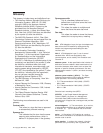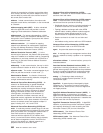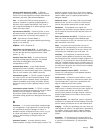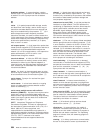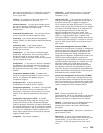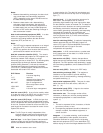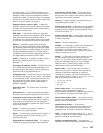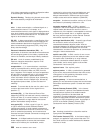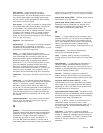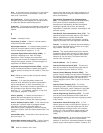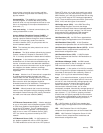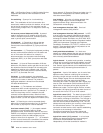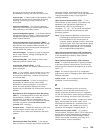LUs) without regenerating complete configuration tables
or deactivating the affected major node.
Dynamic Routing. Routing using learned routes rather
than routes statically configured at initialization.
E
echo. In data communication, a reflected signal on a
communications channel. For example, on a
communications terminal, each signal is displayed twice,
once when entered at the local terminal and again when
returned over the communications link. This allows the
signals to be checked for accuracy.
EIA 232. In data communication, a specification of the
Electronic Industries Association (EIA) that defines the
interface between data terminal equipment (DTE) and
data circuit-terminating equipment (DCE), using serial
binary data interchange.
Electronic Industries Association (EIA). An
organization of electronics manufacturers that advances
the technological growth of the industry, represents the
views of its members, and develops industry standards.
EIA unit. A unit of measure, established by the
Electronic Industries Association, equal to 44.45
millimeters (1.75 inches).
encapsulation. (1) In communications, a technique
used by layered protocols by which a layer adds control
information to the protocol data unit (PDU) from the
layer it supports. In this respect, the layer encapsulates
the data from the supported layer. In the Internet suite
of protocols, for example, a packet would contain
control information from the physical layer, followed by
control information from the network layer, followed by
the application protocol data. (2) See also
data link
switching
.
encode. To convert data by the use of a code in such
a manner that reconversion to the original form is
possible. (T)
end node (EN). (1) See
Advanced Peer-to-Peer
Networking (APPN) end node
and
low-entry networking
(LEN) end node
. (2) In communications, a node that is
frequently attached to a single data link and cannot
perform intermediate routing functions.
entry point (EP). In SNA, a type 2.0, type 2.1, type 4,
or type 5 node that provides distributed network
management support. It sends network management
data about itself and the resources it controls to a focal
point for centralized processing, and it receives and
executes focal-point initiated commands to manage and
control its resources.
Ethernet. A 10-Mbps baseband local area network that
allows multiple stations to access the transmission
medium at will without prior coordination, avoids
contention by using carrier sense and deference, and
resolves contention by using collision detection and
delayed retransmission. Ethernet uses carrier sense
multiple access with collision detection (CSMA/CD).
exception. An abnormal condition such as an I/O error
encountered in processing a data set or a file.
exception response (ER). In SNA, a protocol
requested in the form-of-response-requested field of a
request header that directs the receiver to return a
response only if the request is unacceptable as received
or cannot be processed; that is, a negative response,
but not a positive response, can be returned. Contrast
with
definite response
and
no response
.
exchange identification (XID). A specific type of basic
link unit that is used to convey node and link
characteristics between adjacent nodes. XIDs are
exchanged between link stations before and during link
activation to establish and negotiate link and node
characteristics, and after link activation to communicate
changes in these characteristics.
explicit route (ER). In SNA, a series of one or more
transmission groups that connect two subarea nodes.
An explicit route is identified by an origin subarea
address, a destination subarea address, an explicit
route number, and a reverse explicit route number.
Contrast with
virtual route (VR)
.
explorer frame. See
explorer packet
.
explorer packet. In LANs, a packet that is generated
by the source host and that traverses the entire source
routing part of a LAN, gathering information on the
possible paths available to the host.
exterior gateway. In Internet communications, a
gateway on one autonomous system that communicates
with another autonomous system. Contrast with
interior
gateway
.
Exterior Gateway Protocol (EGP). In the Internet
suite of protocols, a protocol, used between domains
and autonomous systems, that enables network
reachability information to be advertised and
exchanged. IP network addresses in one autonomous
system are advertised to another autonomous system
by means of EGP-participating routers. An example of
an EGP is the Border Gateway Protocol (BGP).
Contrast with Interior Gateway Protocol (IGP).
F
fax. Hardcopy received from a facsimile machine.
Synonymous with
telecopy.
File Transfer Protocol (FTP). In the Internet suite of
protocols, an application layer protocol that uses TCP
and Telnet services to transfer bulk-data files between
machines or hosts.
698 MRS V3.2 Software User’s Guide




